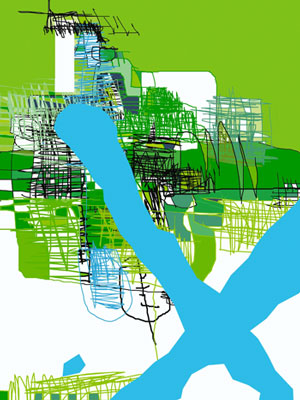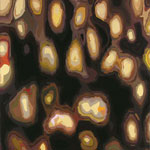To over-determine a work of art, finding meaning where there is none, might well be the bane of good art and a healthy art culture, not to mention a would-be critic.

Scott Barber ... untitled, 2003... urethane on aluminum, 84 x 60 inches... Courtesy of Barry Whistler Gallery
As the old adage goes, sometimes a cigar is only a cigar. Wouldn’t it just be the trap of yesterday’s critic to determine a work’s meaning, much less its greater cultural significance, by way of its setting? That said, I cannot help but relate Altered States to its context: its setting not so much within the hurly-burly whiz-bang of global image-making, but as a show located in the peculiarly modern lunar landscape of the University of Texas at Dallas. There seems a correlation between the flatness of the fourteen pieces of Altered States and the greater urban planarity and unilateral architecture of the show’s context, but it is not a one-to-one relationship between the two. Rather, the broad level smoothness of this Texan landscape corroborates the predominance of the picture plane at this UTD show in supporting, confirming and constituting what we might consider our shared ontology of the screen.
The super-urban landscape so prevalent in outer Dallas — where sublime and beautiful highway interchanges abound, big discount retailers dominate, and flat, rolling plains simultaneously fill and make voids — not only abets but constitutes this current cultural condition. By “ontology of the screen” I mean a certain North American cultural condition characterized by neo-futurist rapacity and the slip-and-slide of meaning, intent and belief along surfaces at once crackling and glossy. While art’s Teflon coating has been with us for some time now, bequeathed by the first generation of Pop artists, we ought to concede that it is, by its very nature, a protean condition. The forebear of our present moment (and more precisely, this show) is Warhol, but his ontology of the screen is not exactly our own. That’s the beauty of this ontology: it is forever novel, perennially shiny and new – the dialectic at work forging nowhere quickly, a Prometheus unbound with broken arms and legs and a terrible headache to boot. Clearly, life might be flat, it might have even fallen flat, but it is by no means boring.

Emily Joyce ... Caution without Panic, 2003... Flashe, enamel and pencil on acrylic panel, 40 x 48 inches... Courtesy of Inman Gallery
In bringing together the fourteen pieces in Altered States, John Pomara has made a statement on the relationship between art and technology in the current moment.
Each artist uses or references current technology as a tool for producing artwork, with the majority of this small group using the computer to digitize, manipulate and/or project images in the evolution of individual pieces. Emily Joyce designs images and forms on the computer before printing them out as vinyl adhesions to be stuck to the wall. At Altered States, she has limited her production to two three-by-four foot acrylic panels on the back of which she has painted pop-cum-vegetal forms in the negative. Making paintings that recall Miro, Chris Kysor willfully doodles with his fingers on the touchpad of his computer making simple, child-like forms that are then projected onto the wall and painted. Jeff Yerger makes computer drawings, then transposes them to stencils and sticks them to both the wall and canvas. This results in a collage effect wherein paint is layered on and beneath vinyl stencils that, in the vibrant green work Untitled, meander onto the floor, making the piece at once painting and installation. Scott Barber manipulates photographic images with Photoshop and then transfers them to the canvas by way of a process of formal inversion. Chris Jagers’ work is very architectural, with layered photographic images of real spaces having been shot through digital mediation and then carefully transposed onto large canvases. And the pieces by Marco Villegas and Janet Tyson play on the unit of the pixel as a building block for form-making and representation.
Borrowing an idea from the Dutch art critic and theorist Petran Kockelkoren, we might interpret this show in terms of social service. In using and referencing new technology in their work, these artists have collectively helped to habituate and accustom us to new technology. Such work not only makes the appearance and existence of new technology normative and integral to our everyday existence, but it changes that very existence. Perhaps more provocatively (and in a cyborgian turn), such work makes the human a product of technology as much as a producer. These artists have carried out acts of what Kockelkoren has called “technoèsis;” that is, they give shape to new culture by integrating new technology into their work.[1] While for Kockelkoren the act of technoèsis obstructs art’s autonomy, making it invariably subject to cultural contamination, the artists’ work in Altered States informs us that, in point of fact, art can be culturally contaminated and autonomous at once. The surface sensibility of these artworks breaks with the either/or position of Kockelkoren and presumes a both/and position. It is art that has its cake and eats it too. At Altered States we experience an instance in which art produced within, by and of culture nevertheless propounds its medium specificity – its singularly new medium specificity. We experience a strain of art that is by definition autonomous and contaminated, both pure and impure.
Pomara addresses the role of the artist not merely as the bold mediator of new technology, but as the creator of a new mode of picture making. It is a mode of painting that, while inheriting certain elements from the now-proverbial modernism of Clement Greenberg, invents itself anew, firmly reliant on the computer. Painting has thus taken on a new life – a second modernism as it were – that, like its mid-twentieth century incarnation, is essentially defined by its flatness: its literal screen-like quality and metaphorical generation by way of the screen. Pomara’s intention in bringing together these works has been to set in relief the status of painting in the digital age. At Altered States we are witnesses to canvases hung upright, the wall as the backdrop and support for the work (with the exception of Yerger’s green vinyl stencil), and a traditionally orthogonal visual experience. But while these works hang in traditional painting-fashion, we are not meant to ruminate from afar, to find presence in them nor to transcend through them. Rather, their flatness is meant to purvey process. Flatness functions as a ledger of technique. The object defers itself to the means by which it has been produced. Process, production and technique therefore mark the raison d’être of the pieces in this show.
If process is the works’ collective reason for being, the concept is their apparatus of calibration. The concept is what brings home this new medium specificity of painting in the digital age. Without knowing how and why each piece has been made – how they have been mediated by the computer or intend to mediate the computer – the work shown here could easily fall flat, in the sense of bathos and failure. Without knowing the full breadth and manner of the work by Emily Joyce, for example, her pieces appear to recapitulate the album jacket design of Peter Max in the late 1960s and early 1970s. This similarly holds true for others showing at Altered States. Without knowing Chris Kysor’s process, his work actually looks like Miro redux. Chris Jagers’ work looks like pretty painterly-cum-photographic abstraction at the grand scale. Marco Villegas looks to recapitulate the mid-century color field work of Barnett Newman, Mark Rothko and Morris Louis. Without understanding the role of digital mediation, the photographs by Basualdo might just as well suggest a return to Victorian pictorialism in photography. Yet the obverse of these mitigated detractions reveals the greater affirmative quality of the work. Without even knowing the conceptual seedling from which the work has flowered, the pieces feel good on the eye. Peculiarly, that conceptualism is the vehicle of the work in this show in no way negates each object’s quality as an object of delectation. In keeping with the perverse combination of the contaminated and autonomous, the pure and the impure, that is the driving force of this show, here we have an instance in which the concept has garnered beauty. In other words, the pieces work, both conceptually and as objects at which to look. One walks away from this show feeling like the work itself: as though you have had your cake and eaten it too.
[1] See Petran Kockelkoren, Technology: Art, Fairground and Theatre (Rotterdam: NAi Publishers, 2003).
Images courtesy the artists and the University of Texas at Dallas.
Charissa N. Terranova is an Adjunct Professor in Art History at Southern Methodist University.




